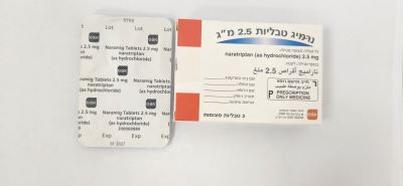Quest for the right Drug

נרמיג טבליות 2.5 מ"ג NARAMIG TABLETS 2.5 MG (NARATRIPTAN AS HYDROCHLORIDE)
תרופה במרשם
תרופה בסל
נרקוטיקה
ציטוטוקסיקה
צורת מתן:
פומי : PER OS
צורת מינון:
טבליות מצופות פילם : FILM COATED TABLETS
עלון לרופא
מינוניםPosology התוויות
Indications תופעות לוואי
Adverse reactions התוויות נגד
Contraindications אינטראקציות
Interactions מינון יתר
Overdose הריון/הנקה
Pregnancy & Lactation אוכלוסיות מיוחדות
Special populations תכונות פרמקולוגיות
Pharmacological properties מידע רוקחי
Pharmaceutical particulars אזהרת שימוש
Special Warning עלון לרופא
Physicians Leaflet
Special Warning : אזהרת שימוש
4.4 Special warnings and precautions for use Naratriptan should only be used where there is a clear diagnosis of migraine. Naratriptan is not indicated for use in the management of hemiplegic, basilar or ophthalmoplegic migraine. As with other acute migraine therapies, before treating headaches in patients not previously diagnosed as migraineurs, and in migraineurs who present with atypical symptoms, care should be taken to exclude other potentially serious neurological conditions. It should be noted that migraineurs may be at risk of certain cerebrovascular events (eg. CVA or TIA). The safety and efficacy of naratriptan when administered during the aura phase, prior to the onset of migraine headache, has yet to be established. As with other 5-HT1 receptor agonists, naratriptan should not be given to patients with risk factors for ischaemic heart disease, including those patients who are heavy smokers or users of nicotine substitution therapy without prior cardiovascular evaluation (see section 4.3). Special consideration should be given to postmenopausal women and males over 40 with these risk factors. These evaluations however, may not identify every patient who has cardiac disease and, in very rare cases, serious cardiac events have occurred in patients without underlying cardiovascular disease when 5-HT1 agonists have been administered. Following administration, naratriptan can be associated with transient symptoms including chest pain and tightness which may be intense and involve the throat (see section 4.8). Where such symptoms are thought to indicate ischaemic heart disease, no further doses of naratriptan should be taken and appropriate evaluation should be carried out (see section 4.8). Reports of transient and permanent blindness and significant partial vision loss have been reported with the use of 5-HT1 agonists. Since visual disorders may be part of a migraine attack, a causal relationship between these events and the use of 5-HT1 agonists have not been clearly established. Serotonin syndrome (including altered mental status, autonomic instability and neuromuscular abnormalities) has been reported following concomitant treatment with triptans and selective serotonin reuptake inhibitors (SSRIs)/serotonin noradrenaline reuptake inhibitors (SNRIs). If concomitant treatment with naratriptan and an SSRI/SNRI is clinically warranted, appropriate observation of the patient is advised, particularly during treatment initiation, with dose increases, or with addition of another serotonergic medication (see Section 4.5). Naratriptan contains a sulphonamide component therefore there is a theoretical risk of a hypersensitivity reaction in patients with known hypersensitivity to sulphonamides. The recommended dose of naratriptan should not be exceeded. Prolonged use of any type of painkiller for headaches can make them worse. If this situation is experienced or suspected, medical advice should be obtained and treatment should be discontinued. The diagnosis of MOH should be suspected in patients who have frequent or daily headaches despite (or because of) the regular use of headache medications. Undesirable effects may be more common during concomitant use of triptans and herbal preparations containing St John’s Wort (Hypericum perforatum). This medicinal product contains anhydrous lactose, patients with rare hereditary problems of galactose intolerance, total lactase deficiency or glucose-galactose malabsorption should not take this medicine. Naramig contains less than 1 mmol sodium (23 mg) per tablet, that is to say essentially ‘sodium-free’.
Effects on Driving
4.7 Effects on ability to drive and use machines Drowsiness may occur as a result of migraine or its treatment with naratriptan. Caution is recommended when skilled tasks are to be performed (e.g. driving or operating machinery).

שימוש לפי פנקס קופ''ח כללית 1994
לא צוין
תאריך הכללה מקורי בסל
לא צוין
הגבלות
לא צוין
מידע נוסף
עלון מידע לצרכן
08.07.21 - עלון לצרכן אנגלית 08.07.21 - עלון לצרכן עברית 08.07.21 - עלון לצרכן ערבית 05.06.23 - עלון לצרכן עברית 17.07.23 - עלון לצרכן אנגלית 17.07.23 - עלון לצרכן עברית 17.07.23 - עלון לצרכן ערבית 04.01.24 - עלון לצרכן אנגלית 17.03.14 - החמרה לעלון 05.03.15 - החמרה לעלון 05.02.17 - החמרה לעלון 20.01.21 - החמרה לעלוןלתרופה במאגר משרד הבריאות
נרמיג טבליות 2.5 מ"ג